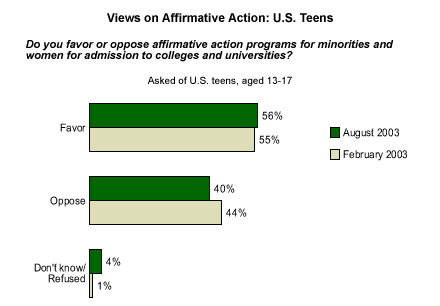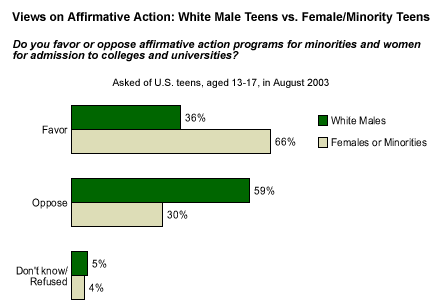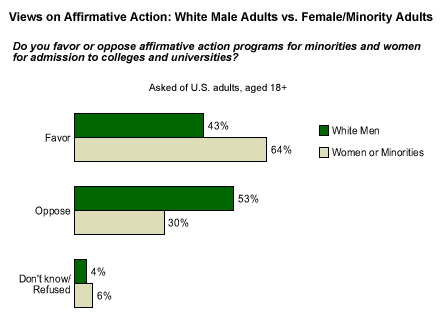By ruling in favor of the University of Michigan last June, the Supreme Court upheld the right of colleges and universities to consider race as a factor in the admissions process. Two months later, in an August 2003 Gallup Youth Survey*, a slight majority of American teens (aged 13 to 17) said they favor affirmative action programs for minorities and women for admission to colleges and universities. A closer look at the numbers shows that the opinions of teens -- many of whom will be directly affected by affirmative action when they apply to college -- vary sharply by race and gender.
Fifty-six percent of teens said they favor college affirmative action programs, while 40% are opposed. These figures do not appear to have changed significantly since the Supreme Court's decision; a February Gallup Youth Survey found 55% of teens in favor and 44% opposed.

White male teens -- the demographic group with the least to gain from affirmative action policies -- are the least likely to favor affirmative action. According to the August survey, only about one in three white male teens favor of college affirmative action programs, while two-thirds of female and minority teens favor them.

This pattern of support was also observed in the February teen poll. In that survey, 38% of white male teens favored affirmative action, compared with 60% of female teens and 71% of minority teens. Gallup polling of the U.S. adult population also finds that most Americans favor affirmative action programs that assist women and minorities in gaining college admission.
Race and gender appear to be major determinants of how adults view these programs, as well. In 2001**, 43% of white men favored college affirmative action programs, as did 64% of women and minorities.

Bottom Line
Recent research on affirmative action, including that compiled in a 2003 book titled, Compelling Interest: Examining the Evidence on Racial Dynamics in Universities, has shown that the benefits of affirmative action extend beyond simply righting past wrongs or helping minorities to succeed. Another main goal of affirmative action at colleges and universities is ensuring diversity in the student body, which many people believe is beneficial to the education of every student, not just minorities or women. However, Gallup research suggests that despite these possible benefits, most white males -- whether teens or adults -- are opposed to affirmative action programs.
*The Gallup Youth Survey is conducted via an Internet methodology provided by Knowledge Networks, using an online research panel that is designed to be representative of the entire U.S. population. The questionnaire was completed by 517 respondents, 201 white males and 316 females or minorities, aged 13 to 17, between Aug. 1 and Aug. 29, 2003. An earlier questionnaire was completed by 1,200 respondents, aged 13 to 17, between Jan. 23 and Feb. 20, 2003. For results based on the total August sample, one can say with 95% confidence that the maximum margin of sampling error is ±4 percentage points. For results based on white males, one can say with 95% confidence that the maximum margin of sampling error is ±7 percentage points. For results based on females or minorities, one can say with 95% confidence that the maximum margin of sampling error is ±6 percentage points. For results based on the total February sample, one can say with 95% confidence that the maximum margin of sampling error is ±3 percentage points.
**Results are based on telephone interviews with 1,017 national adults, 405 white men and 608 women or minorities (four men were or unknown racial/ethnic origin), aged 18 and older, conducted Aug. 3-5, 2001. For results based on the total sample, one can say with 95% confidence that the maximum margin of sampling error is ±3 percentage points. For results based on the sample of white male adults, one can say with 95% confidence that the maximum margin of sampling error is ±5 percentage points. For results based on the sample of women or minorities, one can say with 95% confidence that the maximum margin of sampling error is ±4 percentage points.